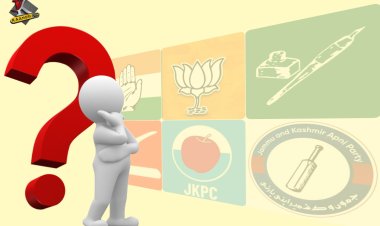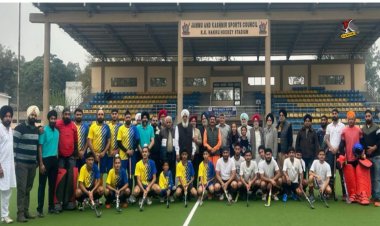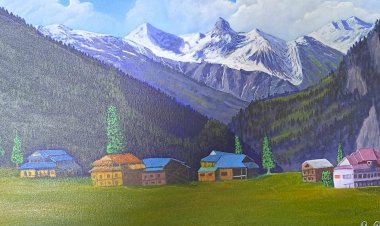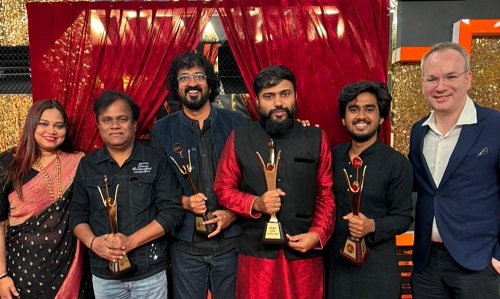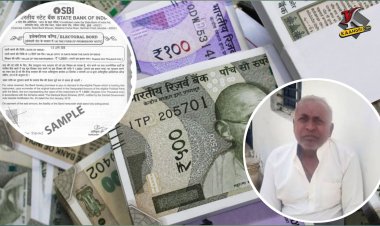THE INK AND EMOTIONS : The Artistic Legacy of Abdul Khaliq

By Ayaz Mughal
In the era of modern technology and computers, the art of Urdu calligraphy seems to be fading away, making it a rare sight these days. However, there is one person who holds a deep passion for this beautiful form of expression. He is Abdul Khaliq Ganaie, hailing from Pogal, a remote area of district Ramban, whose love for Urdu calligraphy has become an integral part of his life.
From a young age, he developed a keen interest in calligraphy, which eventually blossomed into a full-fledged passion. In a fast-paced world where communication is often reduced to the impersonal click of a button he defies the norms and touches lives with a simple yet profound act by writing letters in Urdu calligraphy, using a Qalam (a traditional pen) or a fountain pen. Each word he carefully crafted on paper held a story, conveying the effort, love, and emotions behind it. He wrote countless letters to his relatives, friends, and loved ones across the region, and in return, he received an outpouring of love, respect and prayers. Although he didn't do it for recognition, his gesture was deeply appreciated by everyone. From politicians to bureaucrats, from the elderly to the young, he wrote letters without any self-interest. It is a beautiful way for him to express his love and gratitude to everyone he has encountered in life. This unique idea holds a special place in society for him, especially at a time when people rarely find the time to extend greetings and thanks. He chooses to pick up a pen and convey genuine emotions that flow directly from his heart. I had the opportunity to meet and sit with him, and as I read his heartfelt letters, I discovered a person with a sincere heart, integrity, and humility towards every individual, regardless of their identity.
Having had the opportunity to peruse some of his handwritten letters, I discovered that his talent extended beyond calligraphy alone. His words are intricately woven together, exuding a fragrance of literature. Every letter is filled with love, prayers, and a sense of artistry. It is as if each word is a precious pearl plucked from an oyster and strung together to form a necklace. Through his letters, one could grasp his personality, even if they have never met him in person. In reality, he himself is known to possess a heart of gold.
Professionally, Abdul Khaliq served as a mathematics teacher, progressing to the position of Headmaster and later becoming the Zone Education Officer (ZEO) in Ramban until his retirement. Additionally, he served as the principal of Kamal Public School in Chanderkote for around 14 years after his retirement. In his youth, he also worked as an Urdu Scribe for the "Sandesh" Urdu Daily newspaper for several years when computers were not yet prevalent, and newspapers and books were written by hand before being printed.
To preserve his letters and artistic legacy, a book titled “Maktubat-e-Abdul Khaliq” has been compiled, featuring a selection of his letters. Gathering all the letters was not an easy task, but the endeavor to bring them together and shape them into a book is truly commendable. Dr. Zahir Banihali, took on the responsibility of compiling these letters, paying a real tribute to his passion for both letters and calligraphic art, which is unfortunately diminishing in today’s wolrd. By writing a preface for this book, Justice T.S.Thakur, the ex-Chief Justice of India, expressed his appreciation for commitment to safeguarding this art form and representing his area.
However, alongside these achievements, Abdul Khaliq's life also harbored a sorrowful chapter. His young and only son suffered a tragic accident in 1998, falling from a tree and breaking his spine. For the next 11 years, his son remained bedridden and confined to a wheelchair until he passed away in 2009. The loss of his only son was an immense blow, etching a perpetual sadness in Abdul Khaliq's heart. The loss of a son is immeasurable and irreversible. It has left a void in his life and his family, and when he talks about the time when his son was facing hardships, his eyes reflect deep sadness. Coping with the death of a young son, who was expected to be the caregiver in the old age, is a massive burden to bear. Such a loss profoundly affects the family, shaking them from within, and the process of healing takes time, with some never fully recovering.
Nevertheless, such is the nature of life, where one cannot anticipate the convergence of all desirable elements in a single location. Perhaps, it is in the hand of destiny at play. Yet, amidst the ebb and flow of life’s challenges, he has emerged as beacon of inspiration for the younger generations.
While the book serves as a valuable tribute to his efforts, it also raises concerns about the future of calligraphic art, which is gradually being replaced by computer graphics. It is essential not only to preserve this art form but also to promote it among the younger generation. Urdu calligraphy holds a unique essence that cannot be replicated by digital means. Its preservation and revival will ensure that this beautiful art form continues to thrive and inspire for generations to come.



